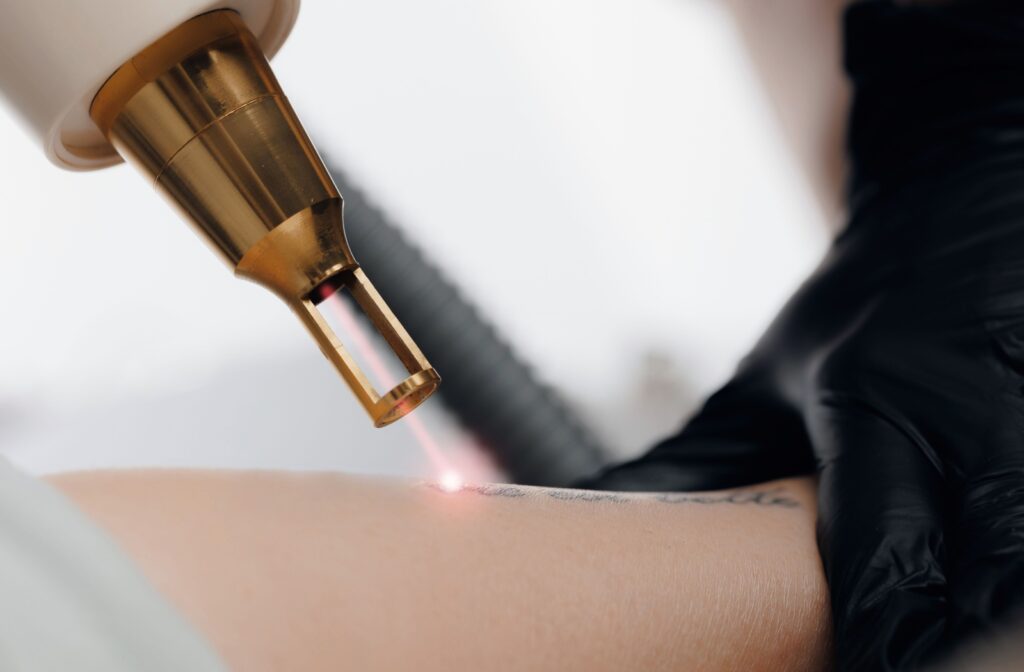Tattoos often tell the story of who we were in a certain moment. But as we grow and evolve, some of those stories no longer feel true to who we are now. When that happens, it’s not about regret—it’s about reclaiming your skin for the version of you that exists today.
If you’re thinking about removing a tattoo, you aren’t alone. It’s more common than ever, and with modern laser technology, like the Fotona Starwalker system, removing unwanted ink is safer and more efficient than ever.
So—how many sessions does it actually take to fully remove a tattoo? Most tattoos can be removed in 6-10 sessions, depending on the size, colour, age, and placement of the tattoo in question.
How Does Laser Tattoo Removal Work?
Tattoo removal isn’t about erasing—it’s about breaking things down.
The Fotona Starwalker laser uses powerful, high-precision light energy to shatter the pigment particles that live beneath your skin. Those particles are then gradually flushed out through your body’s lymphatic system over time. When performed by a professional aesthetician, it’s a safe and minimally invasive procedure.
This is a multi-session process. Each treatment fades the ink layer by layer while leaving your surrounding skin intact. Fotona Starwalker isn’t just high-tech—it’s engineered to target more colours in fewer sessions, which means less pain, less waiting, and more results.
How Long Does It Take to Remove a Tattoo?
Most tattoos can be significantly faded or fully removed in 6–10 sessions. But the exact number depends on a few personal factors, including:
- Ink colours used: Darker shades like black and navy respond more quickly than lighter pigments like yellow or white, which often require more sessions.
- Tattoo age: Older tattoos tend to be easier to fade because the ink has already started to break down.
- Placement: Areas with better circulation (like the arms or torso) typically heal faster than areas with less blood flow (like ankles or fingers).
- Skin tone and immune response: Your body plays a big role in clearing out the ink, so overall wellness and skin health matter.
You’ll need to give your skin 6–8 weeks between sessions—no skipping ahead, no rushing. You’re rebuilding, not speed-running.
Getting Ready for Your Appointment
Prepping your skin before the laser starts makes a real difference. It’s nothing intense—just a few easy steps to set yourself up for success:
- Stay out of the sun for at least 2 weeks before your session (sunburn and lasers are not friends)
- No self-tanner, no tanning beds—they’ll just mess with the laser’s accuracy
- Don’t wax or shave the area for a few days beforehand
- Pause strong skincare (like acids or retinoids) at least a week before
- Wear comfy clothes that won’t rub against the tattoo during treatment
That’s it. No big prep list, just a little skin TLC.
What to Expect During a Session
Tattoo removal sessions generally last between 10 and 60 minutes, depending on the size and complexity of the tattoo.
Before treatment, the area is cleaned, and a topical numbing cream may be applied to reduce discomfort (because no one’s here to be a hero). Protective eyewear is used to shield the eyes from the laser light. During the procedure, short pulses of energy target the tattoo ink, breaking it apart with a sensation that’s often compared to a rubber band snapping against the skin.
Is Laser Tattoo Removal Safe?
Laser tattoo removal is safe, especially when it’s done with the right tech and by someone who knows what they’re doing. The Fontana Starwalker is designed to hit the ink without messing with the surrounding skin.
That said, your skin will go through a bit of a healing phase. These are all normal signs that your body is responding the way it should.
After your session, you may notice:
- Redness and swelling in the treated area
- Mild discomfort or tenderness
- Scabbing or crusting as the skin heals
- Temporary changes in skin pigmentation
The most important part? Taking care of the area between sessions and following the aftercare instructions provided by your aesthetician—think of it as teamwork between you and your skin.
So yes—it’s safe. And more importantly, it’s a step toward taking back your canvas on your own terms.

The Healing Process
Healing between sessions is a huge part of getting the best results. This isn’t the time to rush things—it’s the time to support your body so it can actually clear the ink out.
Follow these tips to promote healing and reduce discomfort:
- Use ice packs to soothe the treated area and manage swelling
- Skip the sun and wear SPF if the area is exposed
- Keep the area clean and dry
- Avoid picking at any scabs or flakes (as tempting as it might be)
- Wear loose clothes over the area to avoid rubbing or irritation
- Drink water like it’s your full-time job—hydration supports healing
Additionally, stick to your treatment plan. Skipping or delaying sessions can stretch the whole process out way longer than it needs to be. If your aesthetician gives you any specialized advice, make sure to listen. This all works together to help your skin heal more efficiently between each session.
Considering Laser Tattoo Removal?
Sometimes it’s healing. Sometimes it’s a hard no to your ex’s initials. Whatever the reason, laser tattoo removal is a way to move forward with skin that feels more like you again.
Iconic Beauty Aesthetics offers experienced, judgment-free care with modern technology that actually works. Let’s rewrite the story on your skin—with technology that works and care that gets you.
If you’re ready to ditch the ink and start fresh, book your consultation today.